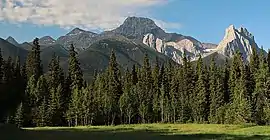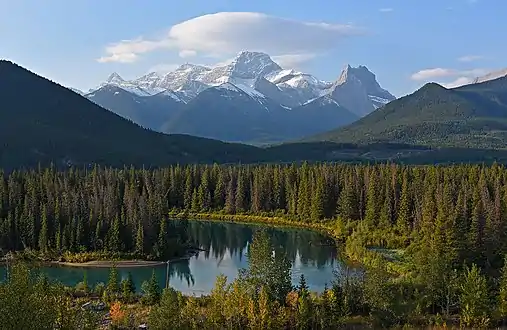Mount Lougheed
Mount Lougheed is a 3,107-metre (10,194-foot) triple-peak mountain located between Spray Lakes Reservoir and the Wind Valley of Kananaskis Country in the Canadian Rockies of Alberta, Canada. The highest summit is known as Peak 2 (3,107 metres). Peak 1 to the northwest is 3,080 metres.[4] Peak 3 to the southeast is 3,010 metres.[5] The nearest higher peak is Wind Mountain, 2.0 km (1.2 mi) to the southeast.[1] Mount Lougheed is a conspicuous landmark that can be seen from Highway 1, the Trans-Canada Highway at Dead Man's Flats which is east of Canmore.
| Mount Lougheed | |
|---|---|
 Mount Lougheed (Peak 1 centered) | |
| Highest point | |
| Elevation | 3,107 m (10,194 ft) [1] |
| Prominence | 242 m (794 ft) [1] |
| Parent peak | Wind Mountain (3153 m)[1] |
| Listing | Mountains of Alberta |
| Coordinates | 50°57′56″N 115°15′45″W [2] |
| Geography | |
 Mount Lougheed Location of Mount Lougheed in Alberta  Mount Lougheed Mount Lougheed (Canada) | |
| Location | Alberta, Canada |
| Parent range | Canadian Rockies |
| Topo map | NTS 82J/14[2] |
| Geology | |
| Age of rock | Cambrian |
| Type of rock | Palliser limestone |
| Climbing | |
| First ascent | 1889 by A. St. Cyr, W.S. Drewry, Tom Wilson[1] |
| Easiest route | Climbing YDS 5.5[3] |
History
Mount Lougheed was named after Sir James Lougheed (1854–1925), a prominent lawyer, politician, senator, and cabinet minister.[1] The mountain was originally named Wind Mountain by Eugène Bourgeau of the Palliser Expedition, but was renamed in 1928 to honor Lougheed after his passing.[1] The mountain's name was officially adopted in 1928 by the Geographical Names Board of Canada.[2] The first ascent was made in 1889 by A. St. Cyr, W.S. Drewry, and Tom Wilson.[1] Mount Lougheed was the scene of the second of three related airplane crashes known as the Rescue 807 Crashes.
Geology
Mount Lougheed is composed of Palliser limestone, a sedimentary rock laid down during the Precambrian to Jurassic periods.[6] Formed in shallow seas, this sedimentary rock was pushed east and over the top of younger rock during the Laramide orogeny.[7]
Climate
Based on the Köppen climate classification, Mount Lougheed is located in a subarctic climate zone with cold, snowy winters, and mild summers.[8] Temperatures can drop below −20 °C with wind chill factors below −30 °C. Precipitation runoff from Mount Lougheed drains into the Bow River which is a tributary of the Saskatchewan River.
References
- "Mount Lougheed". Bivouac.com. Retrieved 2018-11-15.
- "Mount Lougheed". Geographical Names Data Base. Natural Resources Canada. Retrieved 2018-11-15.
- "Mount Lougheed". Summitpost. Retrieved 2019-10-08.
- "Peak one of Mt Lougheed, Canada". Peakbagger.com. Retrieved 2019-10-08.
- "Peak 3 Mt Lougheed, Canada". Peakbagger.com. Retrieved 2019-10-08.
- Belyea, Helen R. (1960). The Story of the Mountains in Banff National Park (PDF). parkscanadahistory.com (Report). Ottawa: Geological Survey of Canada. Archived (PDF) from the original on 2015-10-02. Retrieved 2019-09-13.
- Gadd, Ben (2008). Geology of the Rocky Mountains and Columbias.
- Peel, M. C.; Finlayson, B. L.; McMahon, T. A. (2007). "Updated world map of the Köppen−Geiger climate classification". Hydrol. Earth Syst. Sci. 11: 1633–1644. ISSN 1027-5606.
Gallery
.jpg.webp) Mount Lougheed Peak 1
Mount Lougheed Peak 1 Mt. Lougheed flanked by Wind Mountain and Windtower
Mt. Lougheed flanked by Wind Mountain and Windtower
External links
- Mount Lougheed weather web site: Mountain Forecast